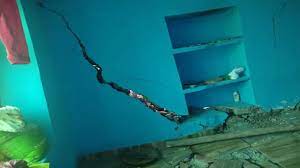New Delhi: The Central Building Research Institute (CBRI) has proposed to develop a disaster-resilient model town to rehabilitate people displaced from the sinking Uttarakhand town of Joshimath.
The Roorkee-based institute of the Council of Scientific and Industrial Research (CSIR), has also suggested a three-pronged action plan for Joshimath that envisages demolition of tilted buildings, safety assessment of existing 4,000 buildings and providing intermediate shelters to the displaced people, CBRI Director R Pradeep Kumar said.
Kumar, along with senior CBRI scientists D P Kanoongo and Ajay Chourasia, visited Joshimath Monday to assess the situation in the town nestled in Himalayan mountain ranges in Kumaon region and deliberated the matter with officials from the National Disaster Management Authority and the Uttarakhand government.
“It is proposed to develop a disaster resilient model town, using cost effective building technology i.E. Confined masonry, along with urban planning on a safe identified site,” he said.
Kumar said the CBRI shall provide habitat planning, design, and construction advice, based on the inputs from the Uttarakhand government regarding number of houses and topography survey at a selected safe identified site.
“The advantages of the technology are – it makes use of locally available construction materials, skills, compatible to local conditions, disaster resilient and affordable,” he said.
The CBRI will commence a detailed study for safety assessment of 4,000 buildings from Thursday to have a deeper understanding about the buildings’ configuration, construction practice, building typology, condition, distress assessment, if any, and monitoring of cracks, he said.
“The field observation shall lead to possible causes for structural damage and comparison with the baseline data, and to decide further strategies for its usage,” Kumar said.
Crack meters shall be installed at different locations to monitor the cracks in identified houses, he said, adding that based on the progressive crack width measurements, the building vulnerability shall be classified into various classes.
The vulnerability of houses in different categories are – highly vulnerable, moderately vulnerable, slightly vulnerable, safe, collapsed/to be demolished, he said.
The activity is likely to be completed within one week, he added.
Kumar said lightweight steel portal frame structures with vertical sides shall be deployed at safe locations to provide intermediate shelters to the rehabilitated people of Joshimath.
-PTI
